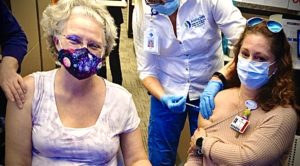Share:
Like many of you, I have personal stories of workplace violence. One incident took place on a normal shift when I was caring for a second-day postoperative cardiac surgery patient. As the night progressed, I could tell my patient’s behaviors were changing. He was picking at lines and becoming fidgety and argumentative. He questioned my care and seemed unaware of the date and time. I helped him to a bedside commode at his request.
I turned away for privacy, and after some time I heard him stand. I turned around and moved in closer to hold his lines and help get him back to bed. He grabbed me around the waist and pulled me into bed with him. He said he had a knife (he did not) and that we were “getting out of there.”
I tried to stay calm, controlled my voice and asked him to let me go. I called out to a colleague in the hallway for help. He came into the room and tried to talk my patient into letting me go. As the situation escalated, someone called a code gray. The patient finally let me go unharmed, but another nurse suffered a kick in the head.
 Sadly, stories of violence in health care settings are all too common. When I was in a hospital supporting a late-night training, a med surg nurse shared a story about a particularly challenging patient on her floor. The patient had been hospitalized for a while and had many medical needs. The patient was horrible to the nursing team, hurling verbal abuse and sexual innuendos, and at times was physically threatening. With tears in her eyes, the nurse said caring for this patient was physically and emotionally exhausting for her and the team. She often thought about leaving the unit — even the profession — because she wasn’t sure if she could do it anymore.
Sadly, stories of violence in health care settings are all too common. When I was in a hospital supporting a late-night training, a med surg nurse shared a story about a particularly challenging patient on her floor. The patient had been hospitalized for a while and had many medical needs. The patient was horrible to the nursing team, hurling verbal abuse and sexual innuendos, and at times was physically threatening. With tears in her eyes, the nurse said caring for this patient was physically and emotionally exhausting for her and the team. She often thought about leaving the unit — even the profession — because she wasn’t sure if she could do it anymore.
The U.S. Bureau of Labor statistics reports that health care and social service industries experience the highest rates of injuries caused by workplace violence and are more than five times as likely to suffer workplace violence injury than workers overall.
The Asante Workplace Violence Prevention Program was formed to ensure a culture of safety that prohibits violence in all forms between patients, visitors and staff. It also has a goal to meet the state requirements to report workplace violence incidents and work toward reducing them.
The program’s operations committee began its work by assessing Asante’s existing policies, procedures and activities related to workplace violence prevention to determine gaps that need to be addressed.
The team discovered opportunities to strengthen our systems, and some of their proposals are now ready to start piloting:
- Pre-code-gray safety huddle. An interdisciplinary huddle will provide a coordinated response for difficult and complex patients with disruptive behaviors. The huddle will include the primary or charge nurse, a direct supervisor and campus security. This group also may also include a provider, pharmacist and spiritual care representative.
- Behavior alerts. When criteria behaviors are documented, a behavior alert flag will be triggered in Epic and scheduling applications to alert staff to the patient’s violent or aggressive behavior. A sign will be placed on the patient’s door to alert disciplines who do not use Epic.
- Patient safety plans and behavior agreements. Caregivers will collaborate with patients to promote safety and identify treatment goals.
- Security purposeful rounding. Campus security officers will round in areas at high risk for violent behaviors.
- Security procedures for patient safety searches in the Emergency Department. Patients will be screened for unsafe items early in the admission process.
- Workplace violence incident review council. This subcommittee will review violent incidents and near-misses to further enhance Workplace Violence Prevention Program measures.
Security purposeful rounding begins at ATRMC at the end of May, with more pilots to come throughout the summer.
Prevent Workplace Violence
Get more information about workplace violence prevention, coping strategies and resources on the Asante Wellness Workplace Violence Prevention![]() page.
page.
If you have a question, please contact the author or relevant department directly.



